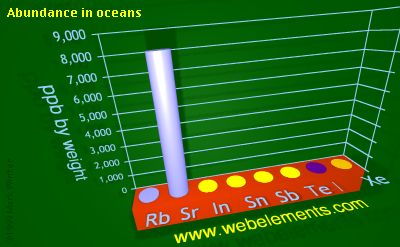Abundance in oceans (by weight)
These data reflect the average composition of ocean water. Values vary slightly with location and depth. Units are parts per billion by weight.

Units
ppb by weight
Notes
Data given in different sources vary somewhat, reflecting the difficulty in assessing these numbers. Values given here are estimates of the average composition of ocean water and are derived by a consensus and averaging process for data abstracted from references 1-5. Values for the more rare elements are probably accurate to within an order of magnitude. Values in any particular location may be very different from those given here.
The units used in WebElements for all abundance data are ppb by weight which means parts per billion by weight, that is mg tonne-3 or mg per 1000 kg. All abundance data are also presented as ppb by atoms, which means atoms of the element per billion atoms.
The reason for rescaling all data is as follows. It is common to see, say, solar abundances expressed as the number of atoms of the element relative to a scale upon which the abundance of hydrogen is defined as 1012. This makes comparison with, say, crustal abundances difficult, since crustal abundances are often expressed in terms of parts per million by weight. Hence a common scale is used throughout and I chose ppb as this gives manageable numbers for most elements.
For access to other abundance data as ppb by weight, select from:
For access to other abundance data as ppb by atoms, select from:
Literature sources
- W.W. Porterfield in Inorganic chemistry, a unified approach, Addison Wesley Publishing Co., Reading Massachusetts, USA, 1984.
- I.S. Butler and J.F. Harrod in Inorganic Chemistry, Principles and Applications, Benjamin Cummings, California, USA, 1989.
- J.E. Huheey, E.A. Keiter, and R.L. Keiter in Inorganic Chemistry : Principles of Structure and Reactivity, 4th edition, HarperCollins, New York, USA, 1993.
- A.M. James and M.P. Lord in Macmillan's Chemical and Physical Data, Macmillan, London, UK, 1992.
- P.O'Neill in Environmental Chemistry, Chapman & Hall, London, UK, 1993.
| 1 | 2 | 3 | 4 | 5 | 6 | 7 | 8 | 9 | 10 | 11 | 12 | 13 | 14 | 15 | 16 | 17 | 18 | |
|---|---|---|---|---|---|---|---|---|---|---|---|---|---|---|---|---|---|---|
|
1
|
2
|
|||||||||||||||||
|
3
|
4
|
5
|
6
|
7
|
8
|
9
|
10
|
|||||||||||
|
11
|
12
|
13
|
14
|
15
|
16
|
17
|
18
|
|||||||||||
|
19
|
20
|
21
|
22
|
23
|
24
|
25
|
26
|
27
|
28
|
29
|
30
|
31
|
32
|
33
|
34
|
35
|
36
|
|
|
37
|
38
|
39
|
40
|
41
|
42
|
43
|
44
|
45
|
46
|
47
|
48
|
49
|
50
|
51
|
52
|
53
|
54
|
|
|
55
|
56
|
* |
71
|
72
|
73
|
74
|
75
|
76
|
77
|
78
|
79
|
80
|
81
|
82
|
83
|
84
|
85
|
86
|
|
87
|
88
|
** |
103
|
104
|
105
|
106
|
107
|
108
|
109
|
110
|
111
|
112
|
113
|
114
|
115
|
116
|
117
|
118
|
| *Lanthanoids | * |
57
|
58
|
59
|
60
|
61
|
62
|
63
|
64
|
65
|
66
|
67
|
68
|
69
|
70
|
|||
| **Actinoids | ** |
89
|
90
|
91
|
92
|
93
|
94
|
95
|
96
|
97
|
98
|
99
|
100
|
101
|
102
|
|||